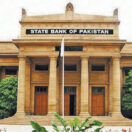Government of Pakistan
Finance Division
Economic Adviser’s Wing
Subject: Change of Base Year & its Impact on Key Economic Indicators
| Table-1: Impact of Re-basing on Macro-Economic Variables | ||||
| Indicators | Fiscal Year 2021 | % Change | ||
| Base Year 2006 | Base Year 2016 | |||
| Real Sector | ||||
| GDP Size (current) (Rs mn) | 47,709,325 | 55,488,010 | 16.3 | |
| GDP Size (current) ($ mn) | 298,650 | 346,757 | 16.1 | |
| Per Capita Income ($) | 1,542 | 1,666 | 8.0 | |
| Population | 211.9 | 222.6 | 5.0 | |
| Fiscal Sector | ||||
| Total Revenue (Rs mn) | 6,903,370 | 6,903,370 | ||
| Total Revenue (% of GDP) | 14.5 | 12.4 | ↓ | |
| Tax Revenue (Rs mn) | 5,272,699 | 5,272,699 | ||
| Tax Revenue (% of GDP) | 11.1 | 9.5 | ↓ | |
| Total Expenditures (Rs mn) | 10,306,691 | 10,306,691 | ||
| Total Expenditures (% of GDP) | 21.6 | 18.6 | ↓ | |
| Current Expenditures (Rs mn) | 9,084,010 | 9,084,010 | ||
| Current Expenditures (% of GDP) | 19.0 | 16.4 | ↓ | |
| Fiscal Deficit (Rs mn) | 3,403,321 | 3,403,321 | ||
| Fiscal Deficit (% of GDP) | 7.1 | 6.1 | ↓ | |
| Public Debt (Rs bn) | 39,861 | 39,861 | ||
| (% of GDP) | 83.5 | 71.8 | ↓ | |
| Primary Balance (Rs mn) | -653,592 | -653,592 | ||
| Primary Balance (% of GDP) | -1.4 | -1.2 | ↑ | |
| Table-1: Impact of Re-basing on Macro-Economic Variables | |||
| External Sector | % Change | ||
| Export ($ mn) | 25,630 | 25,630 | |
| Export (% of GDP) | 8.6 | 7.4 | ↓ |
| Import ($ mn) | 53,818 | 53,818 | |
| Import (% of GDP) | 18.0 | 15.5 | ↓ |
| Remittances ($ mn) | 29,370 | 29,370 | |
| Remittances (% of GDP) | 9.8 | 8.5 | ↓ |
| FDI ($ mn) | 1,862 | 1,862 | |
| FDI (% of GDP) | 0.6 | 0.5 | ↓ |
| CAD ($ mn) | 1,916 | 1,916 | |
| CAD (% of GDP) | 0.64 | 0.55 | ↓ |
| Table-2: Impact of Re-basing from 2005-06 to 2015-16 on GDP size and Growth | |||||
| FY 2021 (Nominal) | FY 2021 (Constant) | ||||
| Indicators | Base Year
2006 |
Base Year
2016 |
Base Year
2006 |
Base Year
2016 |
|
| GDP (Rs million) | 47,709,325 | 55,488,010 | 13,036,381 | 36,489,871 | |
| Increase (%) | 16.3%
(1.16 times↑) |
180%
(2.8 times↑) |
|||
| Table-3: Impact of Re-basing on Structure of GDP (%) | ||
| Percentage Shares | ||
| FY 2020-21 | ||
| Sectors | Base Year 2005-06 | Base Year 2015-16 |
| Agriculture | 19.19 | 23.08 |
| 1. Crops | 6.87 | 7.81 |
| Important Crops | 4.32 | 4.37 |
| Other Crops | 2.24 | 3.16 |
| Cotton Ginning | 0.31 | 0.28 |
| 2. Livestock | 11.53 | 14.44 |
| 3. Forestry | 0.40 | 0.49 |
| 4. Fishing | 0.39 | 0.33 |
| B. Industrial Sector | 19.12 | 18.91 |
| 1. Mining & Quarrying | 2.38 | 1.89 |
| 2. Manufacturing | 12.79 | 12.02 |
| Large Scale | 9.73 | 8.88 |
| Small Scale | 2.12 | 1.93 |
| Slaughtering | 0.94 | 1.21 |
| 3. Electricity, Gas & Water Supply | 1.35 | 2.32 |
| 4. Construction | 2.61 | 2.68 |
| Commodity Producing Sector (A+B) | 38.32 | 41.99 |
| C. Services Sector | 61.68 | 58.01 |
| 1. Wholesale & Retail Trade | 18.82 | 18.18 |
| 2. Transportation and Storage | 12.18 | 10.45 |
| 3. Accommodation and Food Services* | NA | 1.43 |
| 4. Information and Communication* | NA | 2.48 |
| 5. Financial and Insurance Activities | 3.72 | 1.93 |
| 6. Real Estate Activities | 6.97 | 5.70 |
| 7. Public Administration (General Government Services) | 8.21 | 5.01 |
| 8. Education* | NA | 2.81 |
| 9. Human Health & Social Work* | NA | 1.58 |
| 10. Other Private Services | 11.77 | 8.45 |
| GDP (A+B+C) | 100.00 | 100.00 |
*: The Sub-Sectors of Services Sector are newly added components in Re-basing of National Accounts 2015-16.
| Table-4: Impact of Re-basing on GDP Growth (%) | |||||
| Sectors | Base Year 2005-06 | Base Year 2015-16 | |||
| FY 2019-20 (R)* | FY 2020-21(P) | FY 2019-20 (F) | FY 2020-21(R) | ||
| Agriculture | 3.31 | 2.77 | 3.91 | 3.48 | |
| Industry | -3.77 | 3.57 | -5.84 | 7.79 | |
| Services | -0.55 | 4.43 | -1.28 | 5.70 | |
| GDP | -0.47 | 3.94 | -1.00 | 5.57 | |
* R, P & F stand for Revised, Provisional and Final respectively.





